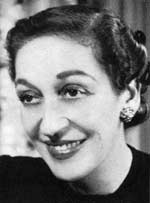Dorothy Fields |
Born Allenhurst, New Jersey July 15, 1905 - Died New York, March 28 1975
Dorothy Fields' father was Lew Fields, the bully-boy half of Weber and Fields, a highly successful 'Dutch comic' act on the vaudeville circuit. They claimed to have originated the classic exchange: 'Who was that lady 1 saw you with last night 'That was no lady, that was my wife.' In the year she was born, Lew Fields had a row with his long-time partner an quit the stage. By the time Dorothy was attending the Benjamin School for Girls her father was a producer of musicals with friends including Cole Porter Richard Rodgers, Lorenz Hart and Oscar Hammerstein II. Lew had gone respectable and did not want his daughter to become either an actress or a lyric writer; her second choice of career was a profession he considered unladylike. Not easily put off, Dorothy sent some of her work to Jimmy McHugh, a staff writer at Mills Music. McHugh was impressed and suggested they write some songs together. The result was enormous hits such as 'I Can't Give You Anything But Love, Baby' and 'On The Sunny Side Of The Street'. With these successes under their belts, Fields and McHugh headed for Hollywood, where they wrote songs for a series of forgettable movies. Then, in 1935, she caught the eye of top composer Jerome Kern. The stage show Roberta was being turned into a movie vehicle for Fred Astaire and Ginger Rodgers, and Jerome Kern had written a new piece of music to introduce a fashion parade. The only problem was that no-one knew how to make the music into a complete song. Fields came up with the lyric which became 'Lovely To Look At', which pleased Kern so much he asked her to collaborate with him on his next project, I Dream Too Much, starring Lily Pons. They went on to write four films together, but unquestionably their finest score was for the Astaire/Rodgers movie Swing Time, one of the classics of movie musicals, with songs including 'Pick Yourself Up', 'A Fine Romance' and the beautiful 'The Way You Look Tonight'. In 1939, Dorothy Fields went back to New York and, with her brother Herbert, wrote the books for three of Cole Porter's hits of the 1940s, Let's Face It, Something For The Boys and Mexican Hayride. But her own pet project was a starring vehicle for Ethel Merman, based on the story of Annie Oakley: the show was called Annie Get Your Gun. She had persuaded Kern to come East to work on the score, but the project had only just got under way when Kern suffered a fatal heart attack. He was replaced by Irving Berlin, a man who always wrote his own lyrics. That is the reason why Dorothy Fields' only credit on one of the biggest of all Broadway musicals is as co-librettist. With A Tree Grows In Brooklyn (1951) Dorothy Fields began to show the beginnings of a more colloquial style. This show was a story about ordinary people and she made sure not to give them unrealistically poetic language to sing. Working with Cy Coleman, Dorothy Fields' career got a fresh wind. She stepped easily into the seedy world of the Fan-Dango Ballroom and the musical Sweet Charity - surely as far from Fred and Ginger as one can get? Her last hit song was from her second collaboration with Coleman, Seesaw(1973). Fittingly, it was entitled 'It's Not Where You Start, It's Where You Finish'. There is a web site devoted to Dorothy Fields at http://www.aldous72.freeserve.co.uk Amongst other things, it features:
<
|
 Dorothy Fields was the first woman to be elected to the Songwriters' Hall
of Fame
Dorothy Fields was the first woman to be elected to the Songwriters' Hall
of Fame